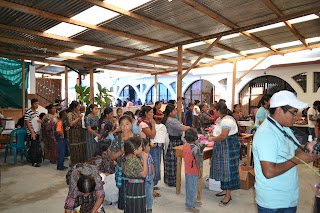 I am humbled by my 16 days in Guatemala. I went from my comfortable life in the U.S. to feeling like a celebrity in Joya de las Flores where the people will bend over backwards to give us everything they have to being confronted head on by the harsh realities and hopelessness of a severely impoverished Pozo Seco. It is very apparent in Joya de las Flores that our continued loyalty to their community has created an impact. After multiple projects and the development of trusting relationships there has been visible progress made since I visited two years ago. The progress is not necessarily a direct result the projects that we have done (painting a school, building a pavilion, or giving therapy to disabled people), but the true progress is in the morale and self worth that these projects create within the community. The community leader was able to build a new bathroom in her house as a result of the money earned from taking students into her home while on one of these trips. She and her family take great pride in that new bathroom with running water and a heated shower.
I am humbled by my 16 days in Guatemala. I went from my comfortable life in the U.S. to feeling like a celebrity in Joya de las Flores where the people will bend over backwards to give us everything they have to being confronted head on by the harsh realities and hopelessness of a severely impoverished Pozo Seco. It is very apparent in Joya de las Flores that our continued loyalty to their community has created an impact. After multiple projects and the development of trusting relationships there has been visible progress made since I visited two years ago. The progress is not necessarily a direct result the projects that we have done (painting a school, building a pavilion, or giving therapy to disabled people), but the true progress is in the morale and self worth that these projects create within the community. The community leader was able to build a new bathroom in her house as a result of the money earned from taking students into her home while on one of these trips. She and her family take great pride in that new bathroom with running water and a heated shower.The second week in Pozo Seco, was much more challenging for me. This community that has an incredible amount of need. On past trips I have observed poverty and taken notice with my eyes, but this experience was different. Not only did I observe poverty through the falling apart roofs, children with bloated bellies from malnutrition, lack of running water, and the consumption of salt at the end of a meal to satisfy hunger cravings, but I had people telling me to me face how poor they are. My host father told me to "send help" because they are poor and he does not have the money to send his children to school. We had multiple young people in the community writing letters to us asking for monetary donations.
Given these unsettling events, I am left with many questions running through my mind; What do we do? Do we just send money as they request? Are students or people who are used to living comfortably in the U.S. ready to visit a place like Pozo Seco? Where do we start?
In hind sight, I realize that development in a community like this will take time. We need to be patient and work WITH the people of this community. I have also learned through my experience that the most important way to make a positive impact on any person or group of people is to change their way of thinking. If there is a way to change the mindset of people in these impoverished communities from one of hopelessness and desperation to one of self worth and possibility, major changes can be made. Empowering people through trusting relationships, guiding conversations, and continued support will lead to the greatest success.
During our time in Guatemala, we met people of one particular organization that does just that through empowering women. It is called Abriendo Oportunidades, "creating opportunities". They work with young women between the ages of 8-14 from rural Mayan communities to teach them skills that allow them to be more independent. Including teaching the girls about managing their own finances, methods of birth control, involving them in sports and combating domestic violence. To combat domestic violence, a group of girls with their mentors go into homes and confront the abusers by explaining directly to them that abuse is unacceptable, even though it is a cultural norm in Guatemala. This organization is currently present in 50 rural Guatemalan communities and is growing.
This video provides more information on the great work that Abriendo Oportunidades does...
http://www.popcouncil.org/publications/playfile.asp?rmidno=73
Overall, Guatemala was an incredible learning experience and I feel very blessed to have gotten the opportunity to learn from the many incredible people that I met along the way. It is a beautiful country that continues to fascinate and amaze me.
Until next time,
- Ellen Lepore
"At times our own light goes out and is rekindled by a spark from another person. Each of us has cause to think with deep gratitude of those who have lighted the flame within us."- Albert Schweitzer











